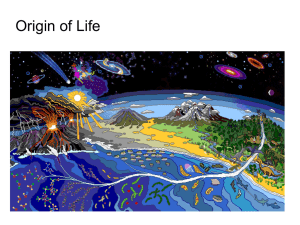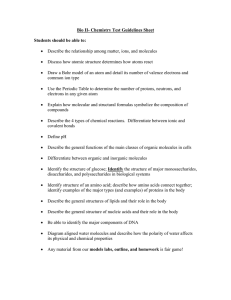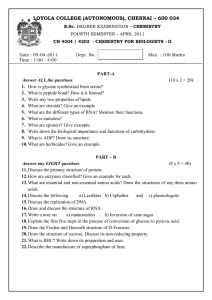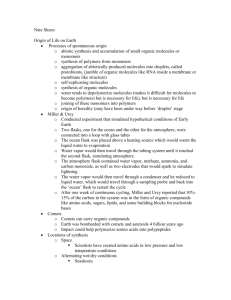Where, how and when life began continues to be a... appeared very fast and could have been present in bubbles...
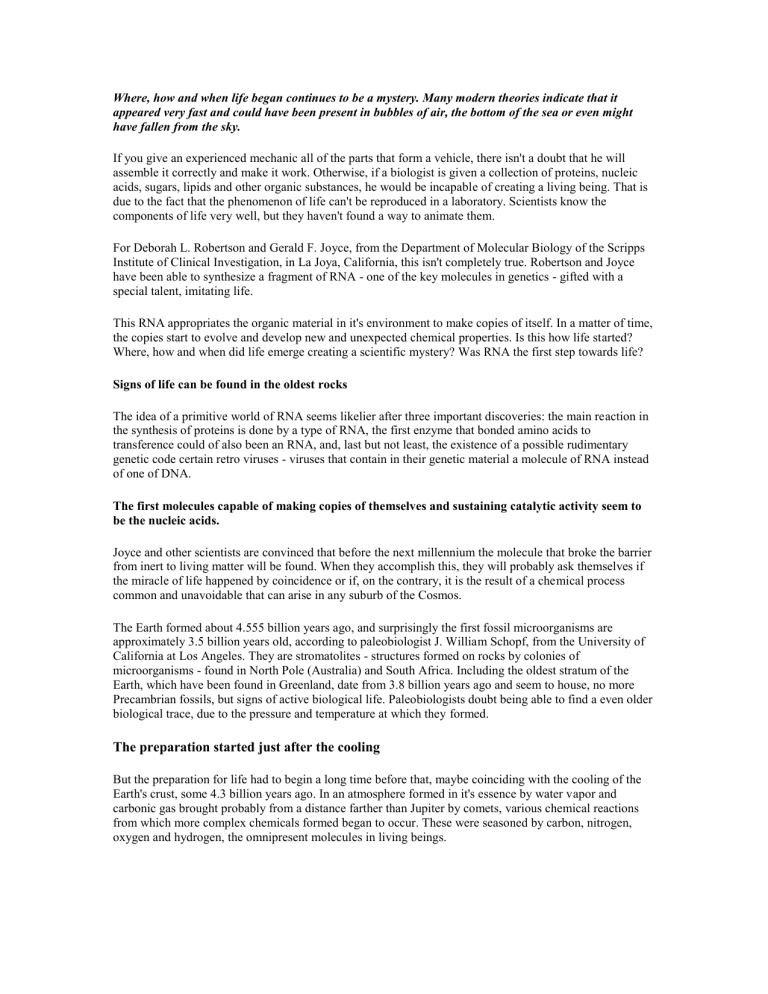
Where, how and when life began continues to be a mystery. Many modern theories indicate that it appeared very fast and could have been present in bubbles of air, the bottom of the sea or even might have fallen from the sky.
If you give an experienced mechanic all of the parts that form a vehicle, there isn't a doubt that he will assemble it correctly and make it work. Otherwise, if a biologist is given a collection of proteins, nucleic acids, sugars, lipids and other organic substances, he would be incapable of creating a living being. That is due to the fact that the phenomenon of life can't be reproduced in a laboratory. Scientists know the components of life very well, but they haven't found a way to animate them.
For Deborah L. Robertson and Gerald F. Joyce, from the Department of Molecular Biology of the Scripps
Institute of Clinical Investigation, in La Joya, California, this isn't completely true. Robertson and Joyce have been able to synthesize a fragment of RNA - one of the key molecules in genetics - gifted with a special talent, imitating life.
This RNA appropriates the organic material in it's environment to make copies of itself. In a matter of time, the copies start to evolve and develop new and unexpected chemical properties. Is this how life started?
Where, how and when did life emerge creating a scientific mystery? Was RNA the first step towards life?
Signs of life can be found in the oldest rocks
The idea of a primitive world of RNA seems likelier after three important discoveries: the main reaction in the synthesis of proteins is done by a type of RNA, the first enzyme that bonded amino acids to transference could of also been an RNA, and, last but not least, the existence of a possible rudimentary genetic code certain retro viruses - viruses that contain in their genetic material a molecule of RNA instead of one of DNA.
The first molecules capable of making copies of themselves and sustaining catalytic activity seem to be the nucleic acids.
Joyce and other scientists are convinced that before the next millennium the molecule that broke the barrier from inert to living matter will be found. When they accomplish this, they will probably ask themselves if the miracle of life happened by coincidence or if, on the contrary, it is the result of a chemical process common and unavoidable that can arise in any suburb of the Cosmos.
The Earth formed about 4.555 billion years ago, and surprisingly the first fossil microorganisms are approximately 3.5 billion years old, according to paleobiologist J. William Schopf, from the University of
California at Los Angeles. They are stromatolites - structures formed on rocks by colonies of microorganisms - found in North Pole (Australia) and South Africa. Including the oldest stratum of the
Earth, which have been found in Greenland, date from 3.8 billion years ago and seem to house, no more
Precambrian fossils, but signs of active biological life. Paleobiologists doubt being able to find a even older biological trace, due to the pressure and temperature at which they formed.
The preparation started just after the cooling
But the preparation for life had to begin a long time before that, maybe coinciding with the cooling of the
Earth's crust, some 4.3 billion years ago. In an atmosphere formed in it's essence by water vapor and carbonic gas brought probably from a distance farther than Jupiter by comets, various chemical reactions from which more complex chemicals formed began to occur. These were seasoned by carbon, nitrogen, oxygen and hydrogen, the omnipresent molecules in living beings.
Millions of years after, under the influence of internal terrestrial heat and solar radiation, the first molecules capable of reproducing themselves and favor catalytic reactions emerged. This crucial event could have occurred 3.8 billion years ago, but, in which conditions was this prebiotic soup cooked?
Comets aborted any attempt at life
In 1953, a young American chemist from Chicago named Stanley Miller carried out an unusual experiment that touched the scientific community. He poured a mixture of ammonia, hydrogen and water vapor, what has been called primitive soup, into a wide container. The chemist wanted to emulate the primitive atmosphere. Once the container was sealed, he caused an electric storm in it's interior. After two weeks of sparks and bubbles, the fluid veered in color. When he analyzed the resulting beverage, Miller proved that at least two amino acids had been formed: alanine and glicine.
Professor Stanley Miller observes a container that has a mixture of gases similar to those present in the primitive atmosphere. The electric discharges simulate thunder.
Since then, the experiment has been repeated combining different atmospheres and sources of energy. In these, 14 of the 20 natural amino acids appear, hydrocarbons, acetic acid, formic acid, sugar, purine bases and other typical organic compounds are present.
Unfortunately, recent studies have indicated that the primitive atmosphere wasn't as reluctant as believed before, instead it was only lightly oxidizing and rich in carbon dioxide, nitrogen, and water. With this composition, the efficiency in laboratory simulations is smaller. Another fact that damages such notion is that the old idea of a prebiotic soup cooked in warm and hospitable waters is completely wrong. Life appeared under the infernal sky of a planet threatened by enormous volcanic eruptions and the impact of comets and meteorites.
The fact that, until 3.8 billion years ago, Earth was bombarded in a violent way by extraterrestrial objects up to 100 kilometers in diameter, capable of evaporating part of the ocean and abort any attempt at life, isn't a coincidence. It is estimated that in the time since 3.9 or 3.8 billion years ago, our planet could have been sterilized between five and ten times. Then, the sky was cleared up of these authentic celestial atomic bombs, even though they have let themselves fall from time to time. Even today planet Earth receives and annual bath of 100,000 tons of meteorites and particles of interplanetary dust. Every shooting star is a minuscule remembrance of our agitated past.
Volcanic eruptions and asteroid impacts, like the one that could have caused the extinction of the dinosaurs, might have made it difficult for the first attempts at life to survive.
But no wrong comes for the a purpose of not doing something right. And what if life rained from the sky?
Comets and some asteroids could be the key to justify why the before mentioned chemical evolution was so short. Half of the mass of comets, for example, is formed by freezing water. The defenders of panspermia have calculated that if 10 of 100 wandering objects that collided in the past could have been comets, all oceans would have filled far more than to the top.
Asteroids aren't left behind. Some of them, like the one that fell on September 28th, 1969 in Murchison,
Australia, are authentic containers of organic substances. The meticulous analysis of this space rock revealed that it contained graphite, 74 amino acids and almost 250 different hydrocarbons, and, what is amazing, the five nitrogenized bases of DNA; which are adenine, guanine, cytosine, thymine and uracil.
It is obvious that the experiment of life couldn't of taken part under the constant threat of comets and asteroids, except for the reagents that were safe from them. But, where? "In the bottom of the ocean", respond the defenders of the hot world hypothesis; which , stated explicitly, is the protection of submarine volcanoes. This hypothesis bases itself on the discovery, about 50 years ago, of a rich ecosystem associated with the volcanic geysers of the Pacific. They are enormous chimneys of rock of which authentic aquatic geysers emerge with boiling water capable of burning all living being.
In spite of that, a type of bacteria named arqueobacteria has installed itself in such a location. Prepared to stand temperatures of up to 250 and 350 degrees Celsius, these anaerobic bacteria - which means that they don't consume oxygen - grow in hostile conditions close to those that the primitive atmosphere presented : little oxygen and a lot of carbon dioxide.
Living fossils in the bottom of the sea
It is very difficult to imagine that life forms that are capable of resisting such high temperatures exist.
Indeed, all biological molecules are destroyed at a temperature of about 150 degrees Celsius. However, arqueobacterias have found a way to stop this from happening. So, for example, the bonds between proteins seem to be reinforced, and the molecule of DNA seems winded up in a opposite way, forming a positive super helix. Through this type of construction, closing certain openings that are left in the DNA of other living things which make it less resistant to heat. For some biologists, the fact that some arqueobacterias are the only creatures capable of surviving in unlikely environments, such also exist in extremely, acid and alkaline mediums, which is a living testimony to the fact that, in spite of the harsh conditions present in a primitive Earth, the first organisms had the opportunity to survive. But there is still a question left unanswered: did life originate in the proximity of the aquatic geysers or, on the contrary, did it get there escaping from the cosmic threats?
Bonbons filled with biological material
American geophysicist Louis Lerma, from the Lawrence Berkeley Laboratory, upholds that the solution could be found in the bubbles that were formed on the surface of the primitive oceans. These bubbles could have played the role, such as Miller's sphere, of biological reactors.
According to this model, the bubbles that floated on the ocean caught molecules reach in carbon, grains of clay and metals, spread in the air by volcanoes and fallen comets. At the time each bubble exploded, it released little drops all around it that, when they evaporated, dragged with them small quantities of organic matter. The sun's rays and thunder did the rest of the work, favoring the synthesis of complex molecules, like amino acids and fragments of DNA and RNA. Finally, rain and snow precipitated these forerunners of living matter to the surface of the Earth. This is how everything would be prepared for the final event.
Created in bubbles, the bottom of the sea or coming from outer space, it is certain that some of the first organic compounds suffered a metamorphosis that made them capable of storing genetic information and, at the same time, carry out catalytical reactions. Where RNA the lucky molecules?, how did they get there?
This question poses a new dilemma. If natural selection can only act when there exists an self replicating system that, also, necessarily bases itself on the same nucleic acids, how could it be explained that RNA evolved to acquire it's genetic material?
Creatures of clay existed in the beginning
For professor Graham Cairns-Smith, from the University of Glasgow, before the first life forms could have existed it is possible that a world of clay organisms was present! Indeed, the crystals in clay possess the ability of replicating themselves, growing and, in a certain way, evolve through natural selection. This is due to the fact that these crystals aren't perfect, but instead they contain small defects that can be repeated.
In this way, crystals that could reproduce better than others or which are more resistant than their
counterparts could exist. In a certain moment, this system of loamy clay could have come to the point where it included in it's structure organic molecules, specifically RNAs, that through the passage of time gained control of the process.
It is not known how then DNA stole the leading role from RNA. Another aspect that also isn't known is how organic matter came together to originate the first cell.
Many mysteries still remain, but let's try to discuss this topic even further by reading an article written by scientist Leslie E. Orgel, an article titled

